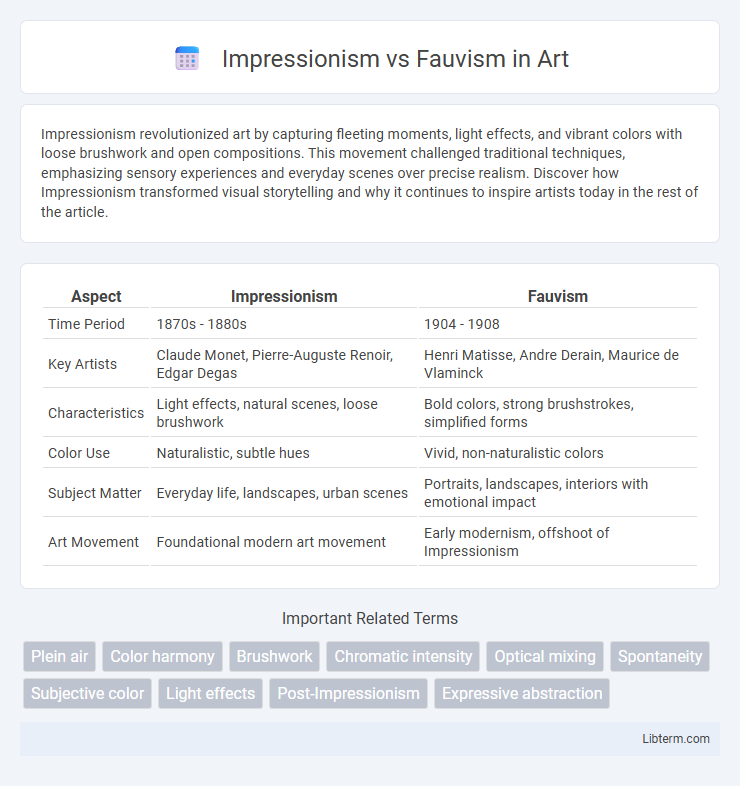Impressionism revolutionized art by capturing fleeting moments, light effects, and vibrant colors with loose brushwork and open compositions. This movement challenged traditional techniques, emphasizing sensory experiences and everyday scenes over precise realism. Discover how Impressionism transformed visual storytelling and why it continues to inspire artists today in the rest of the article.
Table of Comparison
| Aspect | Impressionism | Fauvism |
|---|---|---|
| Time Period | 1870s - 1880s | 1904 - 1908 |
| Key Artists | Claude Monet, Pierre-Auguste Renoir, Edgar Degas | Henri Matisse, Andre Derain, Maurice de Vlaminck |
| Characteristics | Light effects, natural scenes, loose brushwork | Bold colors, strong brushstrokes, simplified forms |
| Color Use | Naturalistic, subtle hues | Vivid, non-naturalistic colors |
| Subject Matter | Everyday life, landscapes, urban scenes | Portraits, landscapes, interiors with emotional impact |
| Art Movement | Foundational modern art movement | Early modernism, offshoot of Impressionism |
Introduction to Impressionism and Fauvism
Impressionism emerged in the late 19th century, characterized by its emphasis on capturing light and natural scenes through loose brushwork and vibrant colors, pioneered by artists like Claude Monet and Pierre-Auguste Renoir. Fauvism followed in the early 20th century, marked by bold, unnatural colors and simplified forms, with leaders such as Henri Matisse and Andre Derain pushing boundaries of emotional expression. Both movements revolutionized modern art by challenging traditional techniques, yet Impressionism focused on fleeting moments of light while Fauvism emphasized emotional intensity through vivid color contrasts.
Historical Context and Emergence
Impressionism emerged in the late 19th century Paris as a response to the rigid academic art, emphasizing light and natural scenes with artists like Claude Monet leading the movement. Fauvism, appearing in the early 20th century, evolved as a more radical reaction, characterized by vibrant, non-naturalistic colors and bold brushwork, pioneered by Henri Matisse and Andre Derain. Both movements reflect shifts in cultural and artistic values during periods of rapid industrialization and urbanization in France, marking pivotal moments in modern art history.
Key Characteristics and Techniques
Impressionism emphasizes light and color through loose brushstrokes and a focus on capturing fleeting moments, often portraying outdoor scenes with natural light. Fauvism distinguishes itself by employing bold, unnatural colors and simplified forms to evoke emotional intensity, using thick, expressive brushwork. Both movements break from realism, but Impressionism leans toward delicate color modulation while Fauvism prioritizes vibrant, raw color contrasts.
Influential Artists of Each Movement
Impressionism was defined by artists such as Claude Monet, Edgar Degas, and Pierre-Auguste Renoir, who emphasized light, color, and everyday scenes with visible brushstrokes and open compositions. Fauvism featured influential figures like Henri Matisse and Andre Derain, known for their bold use of vivid, non-naturalistic colors and simplified forms to evoke emotional intensity. Both movements significantly shaped modern art by challenging traditional techniques and celebrating innovative approaches to color and expression.
Color Theory and Palette Choices
Impressionism emphasizes natural light and a softer, more muted palette with colors often mixed optically to capture the transient effects of light and atmosphere. Fauvism, by contrast, employs bold, non-naturalistic colors and flat, vibrant palettes to evoke emotional intensity and artistic freedom, favoring pure pigments applied directly from the tube. The differing approaches to color theory highlight Impressionism's focus on perception and light, while Fauvism prioritizes expressive, subjective use of color.
Approaches to Light and Atmosphere
Impressionism emphasizes capturing natural light and its transient effects on the environment using loose brushwork and soft, blended colors to depict atmospheric changes. Fauvism, contrastingly, employs bold, non-naturalistic colors and simplified forms to convey emotional intensity rather than realistic light conditions. While Impressionists study shifting light patterns, Fauvist artists prioritize vivid color contrasts to create dynamic, expressive atmospheres.
Subject Matter and Artistic Intent
Impressionism centers on capturing natural light and everyday scenes with an emphasis on fleeting moments and atmospheric effects, reflecting a desire to depict reality as perceived by the human eye. Fauvism embraces bold, vibrant colors and simplified forms to express emotional intensity and subjective experience, often prioritizing artist's emotional response over accurate representation. While Impressionists aim to portray the visual impression of a scene, Fauves seek to evoke mood and symbolism through radical color choices and abstracted shapes.
Reception and Criticism in Their Time
Impressionism initially faced skepticism for its loose brushwork and unconventional use of light, but gradually gained acclaim through exhibitions like the 1874 Impressionist show, influencing modern art significantly. Fauvism shocked audiences with its bold, non-naturalistic colors and simplified forms, receiving harsh criticism for its perceived wildness and lack of structure during its first Salon d'Automne exhibition in 1905. Both movements challenged traditional aesthetics, sparking intense debate among critics and paving the way for future avant-garde developments in 20th-century art.
Lasting Impact on Modern Art
Impressionism revolutionized modern art by pioneering light and color techniques that influenced subsequent movements, emphasizing fleeting moments and naturalistic depictions. Fauvism pushed these boundaries further with bold, non-naturalistic colors and simplified forms, inspiring abstract expressionism and enhancing emotional intensity in visual art. Together, these movements laid foundational principles for 20th-century modernism, shaping contemporary approaches to color theory, composition, and artistic freedom.
Conclusion: Legacy and Significance
Impressionism revolutionized modern art by capturing fleeting light and atmosphere with loose brushwork, influencing countless movements and artists in the 19th and 20th centuries. Fauvism, with its bold, non-naturalistic colors and emotional intensity, pushed the boundaries of expressive possibilities and paved the way for Expressionism and Abstract art. Both movements significantly shaped the trajectory of contemporary art, emphasizing individual perception and transforming visual language.
Impressionism Infographic

 libterm.com
libterm.com